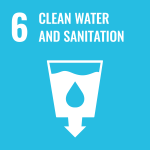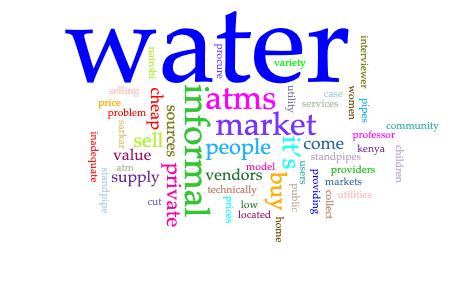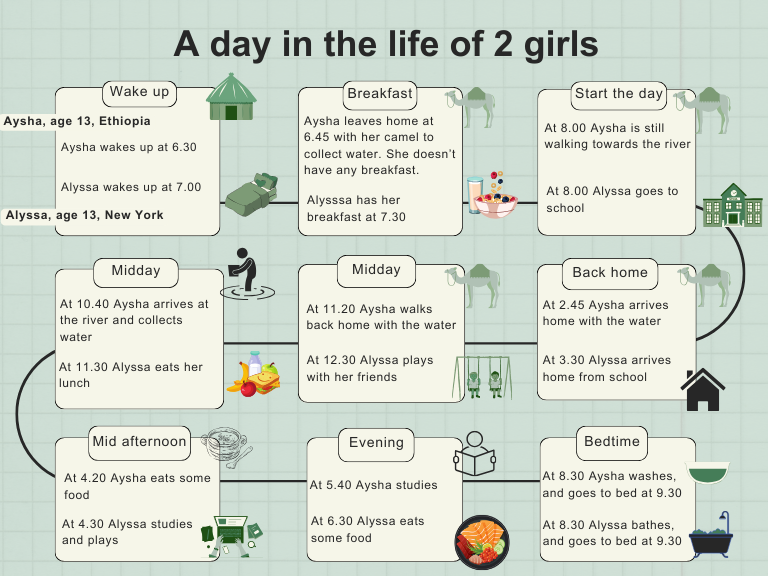Unit 12 Dignity: SDG6
Clean Water and Sanitation

Goal no. 6 of the 2030 Agenda for Sustainable Development aims to ensure availability and sustainable management of water and sanitation for all.
Click on the arrows to reveal more information about SDG6. You don’t need to remember everything you read – the main thing is to get an overview of this Goal.
Information and targets reproduced under the terms and conditions of United Nations websites. Copyright (2023). All rights reserved.
A reminder that links in this e-book do not open in a new tab. If you click on any of the links to a webpage, click the back button in your browser to return here.
Key Vocabulary
Check that you know the meaning and the whole word family of these key words before you begin the Unit. (NB there may be other versions of the word forms – these are the common forms in the context of SDG6). Also notice some common collocations in bold in the ‘Why this goal? and ‘Targets’ sections above. Add any new words, word families or collocations that you would like to remember to your vocabulary book.
Verb Noun Adjective
To equalise equity equitable
To be scarce scarcity scarce
To sanitise sanitation sanitary
To irrigate irrigation irrigated/irrigational
Introduction
In this Unit you’ll find out about aspects of the global water crisis. You’ll learn about the struggle to access drinking water that many people experience, and how this impacts women and girls in particular. You’ll also learn about unethical business practices associated with the sale of water.
- The company aQysta was founded by three engineers who developed renewable hydro-powered pumps to help farmers with irrigation. Watch the animation (1.5mins) (or read the transcript if you are unable to access the animation: aQysta Barsha Pump transcript) and complete the tasks.
- Read this sentence and decide what you think the term ‘commons’ means:
‘Water has to be a commons, because it is the basis of all life’.
- Read this summary, and at each of the four points indicated, identify an SDG associated with the use of the pump that overlaps with SDG6 Clean Water and Sanitation. Use the list of SDGs on the Welcome page to help you.
The Barsha pump is a water pump that does not require any fuel or electricity1 to be operated, runs at zero operating cost 2, and doesn’t emit any greenhouse gas 3. It can be used to irrigate food crops 4.
- Do you know of any innovative methods of dealing with water scarcity in your local context or elsewhere?
Listening – A closer look at the informal water market in Kenya (4.5 mins)
![]()
Credit: The Conversation, Pasha 81. Ozayr Patel, Digital Editor. Licence: CC BY NC ND

Water is a scarce resource and in certain parts of Nairobi Kenya, it is difficult to get. In this listening you’ll hear Prof. Sarkar talking about how this has created a market for informal vendors (sellers) to exist. These vendors profit from the poor in ways which are not always ethical, and yet the vendors are necessary because they provide people with water which they would normally struggle to access.
Before you listen
- Note these acronyms:
ATM – Anytime Water Machine. A water dispensing system powered by solar energy or through electrical energy. NGO – Non-governmental Organisation. A non-profit organisation that operates independently of any government – typically one whose purpose is to address a social or political issue. - In Unit 5 you learned about SDG5 Gender Equality and how a person’s gender affects their life chances. In this listening you’ll hear about the struggle to safely access clean running water that women in some parts of the world experience. Carrying water home, often over long distances, is a gender-based role that has a significant impact on the lives of women and girls, with girls often having to drop out of school to help their mothers collect water. What is your view of this?
- Can you predict some of the business practices that might arise in a situation where a commodity such as water is scarce but also essential?
- Look at the word cloud created from the transcript. The most frequently used words (the biggest ones in the cloud) are: water (41), informal (7), market (6), ATMs (6), sell (4), private (4), people (4), buy (4), vendors (3). With the title in mind (‘A closer look at the informal water market in Kenya’) create a sentence that uses as many of these words as possible and predicts the main point of the listening.

Listen for detail
Play the audio here:
(Or access The Conversation podcast and listen from the start to 4.31mins).
Before you listen answer the question on the first card below, then use the arrow in the bottom right-hand corner to progress to the next card. Listen carefully to the first part of the podcast (0 – 2mins 24) for the specific information you need to answer the question on each card, pausing the audio if you need time to complete the task.
Download the transcript here: Unit 12 listening transcript
Reading – India: why collecting water turns millions of women into second-class citizens
Before you read
- In the listening in Unit 6 (‘Women in the Indian parliament’), the infographic in Unit 8 (The global education crisis), and the reading in Unit 10 (Affordable housing proves life-changing for the urban poor) you learned the word ‘caste’. Can you give a definition?
- Read the title and explain the term ‘second-class citizen’.
- Water collection is a gender-specific role that has a severe impact on every aspect of women’s lives. Can you predict what some of these impacts might be?
Skim read & Read for detail
India: why collecting water turns millions of women into second-class citizens

Introduction
A family in India needs fresh water. But this family can’t just turn on a tap. Instead, the women in the household must walk to fetch it, sometimes travelling miles carrying plastic or earthenware pots, possibly with a child or two in tow, to the nearest safe source – regularly repeating the journey up to three times a day. In the scorching summer months of April and May, when temperatures regularly exceed 40C, it is a particularly gruelling daily ritual – and when they get home they must complete their other household chores: cooking, washing, bringing up the children, even helping on the family farm.
These women are reminiscent of the many-armed Hindu goddess, Durga – they have so many daily tasks, they could doubtless do with an extra set of hands. But they aren’t the exception. This is the reality for millions of women in India. From the Western Ghats and the mountainous north-east to the arid desert state of Rajasthan, women across the country act as water collectors. And this gender specific role has a severe impact on every aspect of their lives, from their health and social life to education and their ability to have a real say in the community.
It is estimated that 163m Indians still don’t have access to clean, running water. Until that’s fixed, this significant national problem will prevail, with women paying the biggest price.
A woman’s burden
Water collection in India is a woman’s job, irrespective of her physique – and there’s no respite, even when she’s menstruating, ill, or has something else to do. As groundwater resources are placed under increasing pressure due to over-reliance and unsustainable consumption, wells, ponds and tanks can also regularly dry up, escalating the water crisis and placing a greater burden on women to travel long distances. Access to unsafe drinking water also results in the spread of water-borne diseases. And women are often the first victims of both water scarcity and water pollution.
In urban areas, long queues of women with colourful plastic water pots are eye-catching. But such images also highlight problems of water scarcity and the long waits they endure for the water tankers that deliver it in cities.
Urban woman, especially on the outskirts of cities and in slum areas, face the particular burden of this water scarcity. In some areas, water is occasionally supplied in the middle of the night, meaning that these women are deprived of sleep and their productivity is affected. Indeed, there are women in the global south who are denied education purely because they have to collect water rather than go to school. In fact, one report revealed that almost 23% of girls in India drop out of school on reaching puberty due to a lack of water and sanitation facilities.
When girls have to drop out of school to help their mothers collect water and perform other household tasks, they are denied their right to education – which is now a fundamental right under Article 21A of the Indian Constitution. The saying goes: “Educate a woman, and she shall educate her family” – well, not these women. And because they’re missing out on the opportunities education provides, so are their other family members.
Collecting water is an irksome journey, especially in dry areas during heat waves. But it can be a dangerous one, too. Women may risk physical attack, for example, or abuse. The situation is made worse by the lack of adequate sanitation facilities both at home and en route to the water source. And things are even worse for women from the lower strata of society who are even denied access to water sources like public wells. This caste discrimination persists even though the Indian Constitution – which ensures equal access to public wells without any discrimination based on religion, race, caste, and sex – is 70 years old.
What the law says
India is a federal democratic country divided into the centre (or union government), 29 states, and seven union territories. The power to make laws is divided between the union government and the states as per Schedule 7 of the Constitution of India, 1950. Accordingly, state governments can legislate on issues related to water, except for those matters involving inter-state rivers and water disputes.
However, the central government has also initiated several programmes and policies to ensure universal access to water in rural and urban areas, such as the National Rural Drinking Water Programme. Access to water is, after all, a fundamental right, covered by the “right to life” that is guaranteed by the Constitution. Indeed, Indian law far predates the international human rights regime on this. The broader human right to water was only recognised in 2002 under General Comment 15 of the UN Committee on Economic, Social and Cultural Rights (CESCR).
The three obligations on states regarding the human right to water – “respect, protect and fulfill” – have been recognised by the Indian courts in several cases (such as Subhash Kumar v State of Bihar, 1991 and Vishala Kochi Kudivella Samprakshana Samiti v State of Kerala, 2006). However, there is no legislation in India that explicitly recognises and implements this fundamental right to water. Instead, every five years, each new government brings with it its own pet programmes for water supply – and none of them have genuinely addressed the issue of water collection for women nor suggested any practical way to ease their burden.
How to tackle the crisis
Several parts of India face severe water scarcity and drought during the summer months. The reason for this water scarcity lies at the grass-roots level – unsustainable water consumption and unscientific ways of managing water supply. Traditional water sources and groundwater recharging points, such as tanks, ponds, canals and lakes, are either neglected, polluted or used or filled in for other purposes.
Only with the constructive involvement of all of society’s stakeholders can this problem be solved. And it must be solved soon. With the increasing threat of climate change, water scarcity could soon be an irreparable issue – and not just for women, but for everyone in society.
NB This version of the article, with permission from the author, does not include the hyperlinks to supporting articles found in the original. Click the title for the full version of the text, published under a CC BY ND licence in The Conversation, which should be used for reference and sharing.
Vocabulary – Synonyms: Talking about difficult or unpleasant tasks
Grammar – Impersonal passive
The passive voice is often used when the writer wants to highlight the focus of an action, rather than the person or thing that caused it. There are several examples In the text (‘Why collecting water turns millions of women into second-class citizens’) of the passive voice being used to avoid mentioning the doer of the action, as in this sentence:
‘It is estimated that 163m Indians still don’t have access to clean, running water’.
Grammar focus – The impersonal passive
‘It is estimated that 163m Indians still don’t have access to clean, running water’.
The impersonal passive is used when we don’t want to, or are unable to, cite legitimate sources for what we are saying. In this case the writer doesn’t want to cite, or doesn’t know the source of this statistic.
We use the structure: It + passive verb (be + past participle) + that clause
This structure is a formal way of reporting thoughts, beliefs and opinions and is common in media reporting, though note that for writing to remain ethical the passive voice should not be used to obscure a source or avoid accountability by failing to name them.
Practice
Complete each of the common impersonal passive constructions with your own idea or opinion about the role of women and girls in water collection. The first one has been done as an example.
- It is estimated that 163m Indians still don’t have access to clean, running water and women pay the biggest price.
- It is expected that…
- It is known that…
- It is fair to say that…
- It is believed that…
- It is thought that…
Data Visualisation – A day in the life of two girls
In both the reading and the listening you learned that water collection is a gender-specific role that has a severe impact on every aspect of women’s and girl’s lives. In this infographic the daily routines of two girls – Aysha in Ethiopia, and Alyssa in the USA – are contrasted to show how water insecurity can exacerbate inequalities. Read the infographic and find out how water collection impacts Aysha’s life, and how her daily routine compares with Alyssa’s.

The infographic is based on information in this report: United Nations Children’s Fund (2017) Thirsting for a Future: Water and Children in a Changing Climate. Figure 12, pp. 36-37, and is designed to show how much time women and girls spend collecting water, and how that can affect how much time they have to do other things such as go to school. It’s not an exact representation of how time is spent.
Download the transcript here Unit 12 Infographic transcript
Writing
In this Unit you’ve learned about water scarcity and the burden of water collection on women and girls. This story of communities in Jamaica who regularly suffer drought illustrates how improving water security has benefits not just for health and food production, but for school attendance, cost of living, and environmental protection.
Read the story about Clarendon in Jamaica and write a response to it that incorporates what you know about the struggle to access water and SDG6 Clean Water and Sanitation. Write about:
- The problem of water scarcity in this local context.
- The solutions.
- The outcomes.
- Any other topic relevant to the challenges of water scarcity and SDG6.
Local Communities in Northern Clarendon, Jamaica, Benefit from Improvements in Water Security and Sanitation
Residents in communities of Northern Clarendon, Jamaica, are facing water stress. Without water, sanitation and hygiene are at risk; food production is hampered; and school attendance rates are also affected.
The United Nations Environment Programme Cartagena Convention Secretariat partnered with the Clarendon Parish Development Committee Benevolent Society (CPDCBS) to implement sustainable solutions to address water scarcity, sanitation, and build community awareness about environmental protection and pollution reduction. Efforts included the installation of rainwater harvesting systems, handwashing stations, wastewater reuse systems, and labelled waste disposal bins to encourage recycling in schools.
Gutters were installed to catch rainwater and fill tanks. A solar power system was also set up at the schools to pump water from the tanks, which will contribute to less dependency on petrol and fossil fuels.
“Before this programme, we had severe water challenges, especially this time around. The drought can be harsh on us and we have to purchase water which is very expensive, and considering the fact that the cost of fuel is going up then you know that the cost of water will also go up. At this point, all our tanks are catching their own water and this will build our water capacity. We are just waiting on the rain to fall,” said Ms. Aldith Stewart, Principal of Park Hall Primary and Infant school.
Department of Economic & Social Affairs Statistics Division (2022) ‘Bringing Data to Life: SDG impact stories from across the globe.’ Available at: https://unstats.un.org/sdgs/report/2022/SDG2022_Flipbook_final.pdf
Speaking
Read the summary and answer the questions that follow:
SDG6 Summary
Sustainable management of water resources and access to safe water and sanitation are essential for unlocking economic growth and productivity, and provide significant leverage for existing investments in health and education. The natural environment, e.g. forests, soils and wetlands, contributes to management and regulation of water availability and water quality, strengthening the resilience of watersheds and complementing investments in physical infrastructure and institutional and regulatory arrangements for water access, use and disaster preparedness. Water shortages undercut food security and the incomes of rural farmers, while improving water management makes national economies, the agriculture and food sectors more resilient to rainfall variability and able to fulfil the needs of growing populations. Protecting and restoring water-related ecosystems and their biodiversity can ensure water purification and water quality standards.
Reproduced with kind permission of the UN Environment Programme. Copyright (2023). All rights reserved.
- In Units 11 and 12 you’ve seen how the failure to meet SDG16 Peace, Justice and Strong Institutions and SDG6 Clean Water and Sanitation leads to an absence of dignity in many people’s daily lives. What absences of dignity are visible in your local context?
- Improved drinking water, sanitation and hygiene play an underpinning role in human progress, including health, education and poverty reduction. Can you think of overlaps between SDG16, SDG6 and any other SDG? Use the table on the Welcome page to help you.
- Can you give a definition or a synonym for the words in bold above?
A reminder that if you have access to the internet and are studying by yourself without other people to practice your spoken English with, you can use artificial intelligence (AI) to gain fluency practice. See here for instructions and prompts.
Here is a prompt related to this Unit:
‘Let’s have a dialogue about water collection. Give me your opinion about the way it negatively impacts the lives of women and girls in many countries, and ask me about my opinion.’
Extension activities
After every two Units you are offered a choice of extension tasks. Use the menu bar on the left-hand side of the screen to access Extension Activities Units 11 and 12.
End of Section 3 – Struggle
This is the end of Section 3. Think about:
- Four key things that you found out by working through the topics (SDG8 Decent Work and Economic Growth, SDG11 Sustainable Cities and Communities, SDG16 Peace, Justice and Strong Institutions, and SDG6 Clean Water and Sanitation).
- One language skill that you think you have developed a bit further.
- Some new vocabulary items that you have mastered (i.e. you can remember them and use them appropriately).
- An area of language that you would like to develop further.
- Any lifestyle change that is possible in your context to help achieve the aims of one or more of these SDGs.

